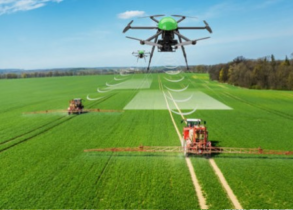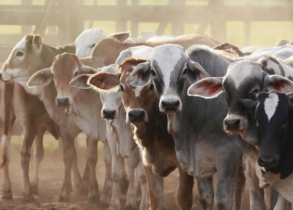GREEN REVOLUTION
Introduction and Background
- The term “Green Revolution” refers to a significant transformation in agriculture that occurred primarily during the 1960s in India. This period marked the introduction and development of High Yielding Variety (HYV) seeds, leading to a substantial increase in the production of food crops, especially rice and wheat. The objective of the Green Revolution was to alleviate hunger and poverty by dramatically increasing agricultural output. This agricultural transformation involved the adoption of modern farming techniques and technologies, including the use of HYV seeds, mechanization with tractors, enhanced irrigation facilities, and the application of chemical fertilizers and pesticides.
Need for the Green Revolution
- Short-Term Objective: To address the immediate hunger crisis in India, particularly during the 2nd Five Year Plan.
- Long-Term Goals: To modernize agriculture based on rural and industrial development, provide employment, conduct studies and biological tests for stronger plant breeds, and globalize agricultural technology.
- Employment: Would in turn help to provide employment to both agricultural and industrial workers;
- Conduct Studies and Biological Tests: To produce stronger plants which could withstand extreme climates and diseases;
- To globalize agriculture, technology will be spread to non-industrialized nations, and many corporations will be established in major agricultural areas.
Components of the Green Revolution
- High Yielding Variety (HYV) Seeds: These seeds, responsive to chemical fertilizers and having shorter maturity periods, allowed for multiple cropping cycles, significantly boosting productivity.
- Irrigation: Recognized as the second most critical component after HYV seeds, the expansion of irrigation potential was essential due to India’s unreliable rainfall patterns.
- Chemical Fertilizers: Necessary for HYV seeds, which demand a higher intake of nutrients for optimal yields.
- Insecticides and Pesticides: The shift towards monoculture made crops more susceptible to pests, necessitating the widespread use of pesticides for crop protection.
- Agricultural Mechanization and Infrastructure: Mechanization, rural electrification, and the development of agricultural infrastructure played crucial roles in enhancing farm efficiency and productivity.
- Land Reforms and Consolidation: Efforts to restructure land ownership patterns and abolish exploitative systems like the Zamindari were vital for equitable growth.
- Agriculture Credit and Education: The provision of affordable credit and the establishment of agricultural universities facilitated access to new technologies and knowledge.
Phases of Green Revolution
- The Green Revolution, a transformative period in agriculture, significantly impacted global food production, especially in India, where it was introduced to combat food scarcity and improve agricultural productivity. Its implementation can be delineated into several phases, each marked by distinct characteristics, strategies, and outcomes. Moreover, the Green Revolution had multifaceted impacts, both positive and negative, on India’s agricultural landscape, economy, and society.
Phases of the Green Revolution
Phase I (1966-1972)
- This initial phase marked the beginning of the Green Revolution in India, characterized by the introduction of High Yielding Variety (HYV) seeds, primarily wheat, in regions with high irrigation capabilities like Punjab, Haryana, and western Uttar Pradesh. The procurement of 18,000 tonnes of HYV wheat seeds in 1966 was a pivotal step towards modernizing Indian agriculture.
Phase II (1973-1980)
- The second phase witnessed the geographical expansion of Green Revolution technologies beyond the initial regions to include eastern Uttar Pradesh, Andhra Pradesh, coastal Karnataka, and Tamil Nadu. This phase also saw the extension of HYV technologies from wheat to rice, facilitated by the growth in the number of tube wells, which provided a reliable water source for irrigation.
Phase III (1981-1990)
- During this phase, the Green Revolution spread to eastern regions of India, including West Bengal, Bihar, Assam, and Odisha. These areas, previously categorized as low-growth, began to experience significant agricultural productivity due to the adoption of Green Revolution practices.
Impacts of the Green Revolution
Positive Impacts of the Green Revolution
- Increase in Agricultural Production: The introduction of HYV seeds and modern farming techniques led to a significant increase in food grain production, particularly wheat, transforming India into one of the world’s largest agricultural producers.
- Reduction in Food Grain Imports: The success in increasing domestic food grain production significantly reduced India’s reliance on imports, addressing food security concerns.
- Industrial and Rural Employment Growth: The demand for agricultural machinery and inputs spurred industrial development and created numerous jobs in rural areas, enhancing the agricultural and rural economy.
- Technological Advancements and Attitude Shift: The adoption of Green Revolution technologies led to a transformation in farming practices and a positive shift in farmers’ attitudes towards agribusiness.
Negative Impacts of the Green Revolution
- Neglect of Non-Food Grains: The focus on HYV crops led to the marginalization of coarse cereals, pulses, oilseeds, and major commercial crops like cotton and sugarcane.
- Excessive Use of Chemicals: Reliance on synthetic fertilizers and pesticides without adequate training for farmers on their risks led to environmental and health issues.
- Loss of Biodiversity: The emphasis on monocultures and HYV seeds contributed to the extinction of numerous indigenous crop varieties.
- Socio-Economic Disparities: The benefits of the Green Revolution were unevenly distributed, favoring regions with irrigation infrastructure and large-scale farmers, thus exacerbating regional and interpersonal inequalities.
Need for a Second Green Revolution
- The Green Revolution marked a significant milestone in the history of agricultural development, especially for countries like India, enhancing national food security through scientific advancements. However, its environmental and social shortcomings highlight the need for a Second Green Revolution. This new revolution aims to make agriculture more climate-resilient and environmentally sustainable while addressing the needs of smallholder farmers and promoting biodiversity.
Four Pillars That Will Enable a Shift to Green Revolution 2.0
Sustainable Agriculture Planning
- The foundation of Green Revolution 2.0 lies in the strategic planning of sustainable agriculture practices tailored to the unique environmental and climatic conditions of specific regions. For instance, areas that are naturally conducive to growing millets can be revolutionized by providing farmers with accessible and efficient processing facilities, subsidized inputs, and the necessary machinery to facilitate the switch to millet production. Such targeted support not only encourages farmers to adopt crops that are more suited to their local environment but also enhances food diversity and resilience against climate change. This approach exemplifies how thoughtful planning and resource allocation can motivate farmers towards sustainable cultivation practices, benefiting both the environment and the agricultural community.
Integrated Agriculture Policy
- An agriculture policy that seamlessly integrates sustainable practices into its core is essential for incentivizing farmers to cultivate crops that are best suited to their region’s environmental profile. By offering inputs at subsidized rates, the policy framework aims to make sustainable farming both economically viable and attractive for producers. This strategy not only supports a more climate-friendly transition in agriculture but also ensures that the shift is equitable, taking into account the varied socioeconomic backgrounds of farmers. Such policies are pivotal in directing agricultural practices towards sustainability, ensuring that the production system aligns with ecological principles and resource efficiency.
Creating an Enabling Environment
- To foster a sustainable agricultural shift, it is crucial to create an enabling environment that supports even the smallest farmers. This encompasses improved market access, alongside feasible and efficient storage and processing facilities. By removing logistical and financial barriers, this pillar aims to make sustainable farming practices accessible and practical for all farmers, regardless of their scale of operation. The focus on inclusivity ensures that the benefits of sustainable agriculture reach every corner of the farming community, promoting widespread adoption of environmentally friendly practices.
The Evergreen Revolution
- The concept of the Evergreen Revolution encapsulates the goal of increasing agricultural productivity in a manner that is environmentally sustainable, economically viable, and socially just. It emphasizes the need for innovation in farming technologies and practices that not only boost yields but also protect the environment, support farmers’ livelihoods, and ensure food security for all. The Evergreen Revolution calls for a nuanced approach to agricultural development, where new technologies are targeted to benefit the most disadvantaged, and sustainability is a key criterion for innovation. This vision for agriculture demands a shift from merely increasing production to enhancing the sustainability and resilience of the farming ecosystem.
UPSC PREVIOUS YEAR QUESTIONS
1. Why did the Green Revolution in India virtually bypass the eastern region despite fertile soil 2014 and good availability of water? (2014)
2. Which of the following best describe/ describes the aim of the ‘Green India Mission’ of the Government of India? (2016)
1. Incorporating environmental benefits and costs into the Union and State Budgets thereby implementing the ‘green accounting’
2. Launching the second green revolution to enhance agricultural output so as to ensure food security to one and all in the future
3. Restoring and enhancing forest cover and responding to climate change by a combination of adaptation and mitigation measures
Select the correct answer using the code given below.
(a) 1 only
(b) 2 and 3 only
(c) 3 only
(d) 1, 2 and 3










